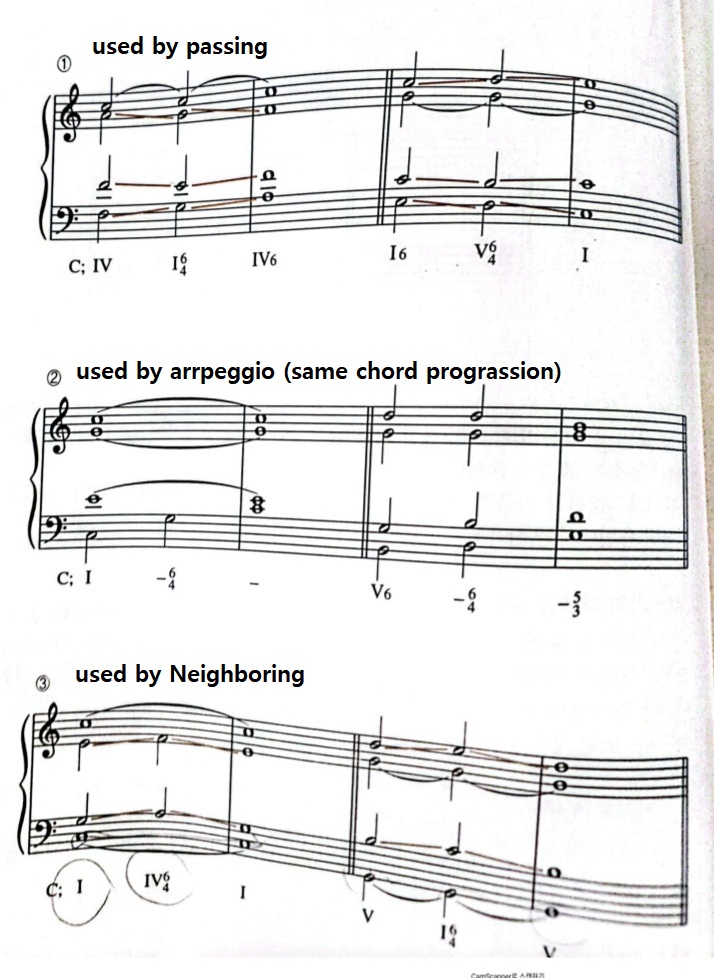- there's an explanation that all the voice parts have to move in a certain direction. but I don't know why the rest of the notes other than the bass and the Perfect fourth have to move in the certain direction. ... I mean, why do I always have to move only with steps?
One of the rules** of counterpoint is to favour smooth movement over angular or jumpy movement. Generally, that means any notes shared between two chords should remain in the same voice, and the rest of the voices move the shortest distance possible while avoiding breaking any other rules. Part of the rationale is that this will make your lines easier to sing. They're also easier for the listener's ear to follow. So, why do these examples unfold as they do? Because they are using the smoothest voice leading possible for these chords in these inversions. Do they need to do this? No, not necessarily.
For example, in the 1st left part of the image, it can't the alto in IV6 come down and become A-F-C-C?
You could do this. You'd be crossing your voices though (the alto would be below the tenor) and there is a rule** against this.
- Why use only I, IV, V? Why not use same intervals chords like a VI - iii64 - VI6 or iii - vii64 - iii6... etc?
Only because these are common progressions. You are correct that the same principles apply to other chord progressions. The progressions you suggest would be unusual but there is nothing illegal about them.
- Not like the example in the image, the Perfect fourth note is can't coming as a normal non-chord tone? not only sus4, Like a Passing Tone, Anticipation, Appoggiatura.. Can't it ever be used like this?
Yes, a perfect 4th can be created by the presence of any normal non-chord tone and the normal rules** governing non-chord tone resolutions apply. In such a case, they are not dissonant because they are perfect 4ths; they are dissonant because there is a non-chord tone involved. 4ths are ubiquitous and in most cases they are not considered dissonant and do not require any special handling. Consider that any voicing of a triad where the root is in the soprano (eg: C-E-G-C) will contain a perfect 4th, and in the vast majority of cases the 4th is not a dissonance.
The examples in the image demonstrate common ways to handle a 2nd inversion triad. They are not showing ways to handle 4ths in general. A 4th between the bass and any other voice is considered a dissonance which is why there are rules** about how to handle them. They are a special case.
Regarding terminology, you used the phrase "Perfect fourth note". 4ths are intervals, not notes, and you need two notes to make an interval. Therefore, you cannot say a particular note is a "perfect 4th note" because that doesn't make sense. If you have a 4th and it happens to be dissonant, then one of the notes can probably be singled out as "the dissonance", but you still wouldn't call it a "perfect 4th note". That term doesn't really mean anything.
- Does it matter if a non-chord tone comes to the bass and becomes a Perfect fourth with the upper voice part?
A-C-A-E(I) -> B-D-A-E(I) -> C-E-A-E(I)
B-D-A-E is half beat and B-D is passing tone and B and E is Perfect fourth but Contrary to the example in the image, it proceeded without anything special. Why can this be done like this?
Like you said, they are passing notes which are non-chord tones. This is not a problem. Why do they not require special handling like in the examples? Because these examples are for handling 2nd inversion triads, not non-chord tones. There's a difference. But you could easily imagine the 2nd chord being B-E-G(#)-E, in which case it would be a passing 2nd inversion chord which follows the examples.
** These rules are really just suggestions. They're also descriptive, not prescriptive. That means they describe what others have done in the past which worked well; they do not command you to do the same in the future. Keep in mind that they were derived several hundred years ago to satisfy the aesthetic tastes of that particular time period. They don't apply to all music everywhere at all times. That said, they are not arbitrary and do have usefulness outside of their original context. Use your judgement. Don't follow them religiously. Even within the music of that time period, you will see many examples of these rules being broken. Often there is some rationale or exception to be noted; sometimes the music just made sense that way for artistic reasons and rules be damned; sometimes it's because you end up getting stuck between two rules and one of them needs to be broken.

